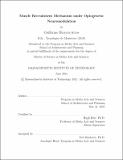| dc.contributor.advisor | Herr, Hugh | |
| dc.contributor.author | Herrera-Arcos, Guillermo | |
| dc.date.accessioned | 2022-03-03T19:29:30Z | |
| dc.date.available | 2022-03-03T19:29:30Z | |
| dc.date.issued | 2021-06 | |
| dc.date.submitted | 2022-02-27T16:49:52.590Z | |
| dc.identifier.uri | https://hdl.handle.net/1721.1/140999 | |
| dc.description.abstract | Neurological conditions in which the communication pathway between the central nervous system and the peripheral neuromuscular components is severed, such as spinal cord injury, affect motor control, limiting patients’ overall quality of life. Functional electrical stimulation (FES) is the most commonly used technology to restore motion. Although FES is used extensively in the clinic, several drawbacks limit its application for long-term use. FES recruits larger motor units before smaller ones, causing muscles to fatigue quickly as it opposes the physiological recruitment mechanism. FES has low-specificity, making neighboring tissues susceptible to simultaneous activation. These drawbacks make force modulation difficult, limiting its controllability.
Recently, functional optogenetic stimulation (FOS) has demonstrated cell-type specificity and millisecond timescale neural control in the peripheral nervous system, enabling reduced fatigue and greater controllability when compared to FES. Given the novelty of FOS, no study to date thoroughly describes how muscle fibers are recruited to generate force under optical stimulation.
Using precise peripheral neural stimulation and sensing, this work shows the first muscle characterization and systematic production of recruitment curves under optical stimulation. These data show significantly higher modulation range under FOS when compared to FES, indicating physiological graded force modulation. This informs how different optical stimulation parameters translate to functional force production and how modulation strategies can be optimized to orchestrate motor recruitment. A mathematical model that describes the biophysical dynamics observed experimentally is also presented. This work lays the foundation for the design of model-informed neural controllers for optically-modulated prosthetics, with the potential to become the first viable alternative to FES for muscle re-animation applications. | |
| dc.publisher | Massachusetts Institute of Technology | |
| dc.rights | In Copyright - Educational Use Permitted | |
| dc.rights | Copyright MIT | |
| dc.rights.uri | http://rightsstatements.org/page/InC-EDU/1.0/ | |
| dc.title | Muscle Recruitment Mechanism under Optogenetic Neuromodulation | |
| dc.type | Thesis | |
| dc.description.degree | S.M. | |
| dc.contributor.department | Program in Media Arts and Sciences (Massachusetts Institute of Technology) | |
| dc.identifier.orcid | https://orcid.org/0000-0002-5282-3354 | |
| mit.thesis.degree | Master | |
| thesis.degree.name | Master of Science in Media Arts and Sciences | |
